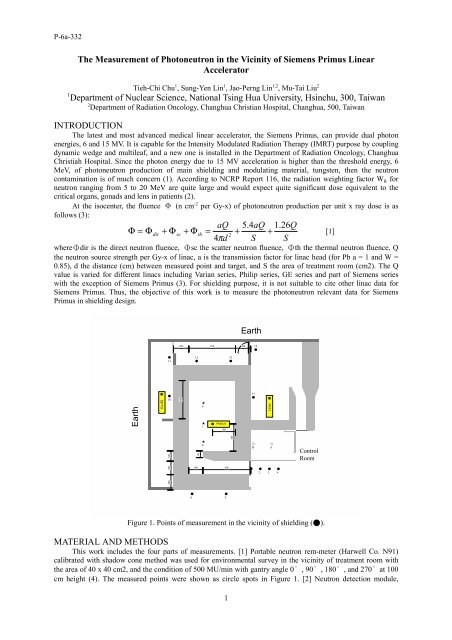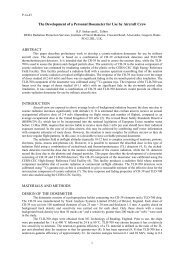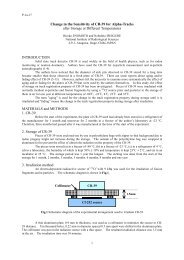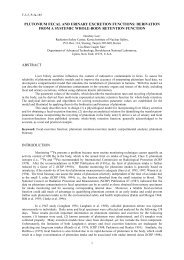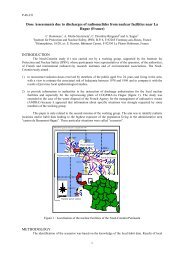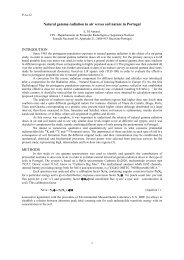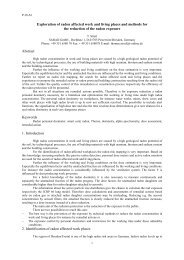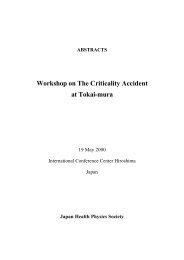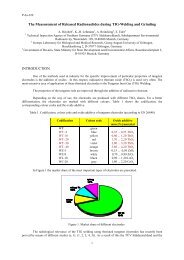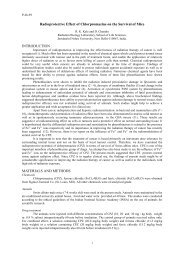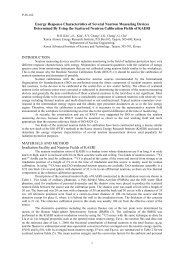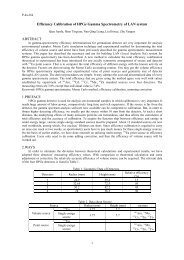The Measurement of Photoneutron in the Vicinity of Siemens Primus ...
The Measurement of Photoneutron in the Vicinity of Siemens Primus ...
The Measurement of Photoneutron in the Vicinity of Siemens Primus ...
Create successful ePaper yourself
Turn your PDF publications into a flip-book with our unique Google optimized e-Paper software.
P-6a-332<br />
<strong>The</strong> <strong>Measurement</strong> <strong>of</strong> <strong>Photoneutron</strong> <strong>in</strong> <strong>the</strong> Vic<strong>in</strong>ity <strong>of</strong> <strong>Siemens</strong> <strong>Primus</strong> L<strong>in</strong>ear<br />
Accelerator<br />
Tieh-Chi Chu 1 , Sung-Yen L<strong>in</strong> 1 , Jao-Perng L<strong>in</strong> 1,2 , Mu-Tai Liu 2<br />
1 Department <strong>of</strong> Nuclear Science, National Ts<strong>in</strong>g Hua University, Hs<strong>in</strong>chu, 300, Taiwan<br />
2 Department <strong>of</strong> Radiation Oncology, Changhua Christian Hospital, Changhua, 500, Taiwan<br />
INTRODUCTION<br />
<strong>The</strong> latest and most advanced medical l<strong>in</strong>ear accelerator, <strong>the</strong> <strong>Siemens</strong> <strong>Primus</strong>, can provide dual photon<br />
energies, 6 and 15 MV. It is capable for <strong>the</strong> Intensity Modulated Radiation <strong>The</strong>rapy (IMRT) purpose by coupl<strong>in</strong>g<br />
dynamic wedge and multileaf, and a new one is <strong>in</strong>stalled <strong>in</strong> <strong>the</strong> Department <strong>of</strong> Radiation Oncology, Changhua<br />
Christiah Hospital. S<strong>in</strong>ce <strong>the</strong> photon energy due to 15 MV acceleration is higher than <strong>the</strong> threshold energy, 6<br />
MeV, <strong>of</strong> photoneutron production <strong>of</strong> ma<strong>in</strong> shield<strong>in</strong>g and modulat<strong>in</strong>g material, tungsten, <strong>the</strong>n <strong>the</strong> neutron<br />
contam<strong>in</strong>ation is <strong>of</strong> much concern (1). Accord<strong>in</strong>g to NCRP Report 116, <strong>the</strong> radiation weight<strong>in</strong>g factor W R for<br />
neutron rang<strong>in</strong>g from 5 to 20 MeV are quite large and would expect quite significant dose equivalent to <strong>the</strong><br />
critical organs, gonads and lens <strong>in</strong> patients (2).<br />
At <strong>the</strong> isocenter, <strong>the</strong> fluence Φ (n cm -2 per Gy-x) <strong>of</strong> photoneutron production per unit x ray dose is as<br />
follows (3):<br />
Φ = Φ<br />
dir<br />
+ Φ<br />
sc<br />
+ Φ<br />
th<br />
aQ<br />
=<br />
4πd<br />
1<br />
2<br />
5.<br />
4aQ<br />
1.<br />
26Q<br />
+ +<br />
S S<br />
where dir is <strong>the</strong> direct neutron fluence, sc <strong>the</strong> scatter neutron fluence, th <strong>the</strong> <strong>the</strong>rmal neutron fluence, Q<br />
<strong>the</strong> neutron source strength per Gy-x <strong>of</strong> l<strong>in</strong>ac, a is <strong>the</strong> transmission factor for l<strong>in</strong>ac head (for Pb a = 1 and W =<br />
0.85), d <strong>the</strong> distance (cm) between measured po<strong>in</strong>t and target, and S <strong>the</strong> area <strong>of</strong> treatment room (cm2). <strong>The</strong> Q<br />
value is varied for different l<strong>in</strong>acs <strong>in</strong>clud<strong>in</strong>g Varian series, Philip series, GE series and part <strong>of</strong> <strong>Siemens</strong> series<br />
with <strong>the</strong> exception <strong>of</strong> <strong>Siemens</strong> <strong>Primus</strong> (3). For shield<strong>in</strong>g purpose, it is not suitable to cite o<strong>the</strong>r l<strong>in</strong>ac data for<br />
<strong>Siemens</strong> <strong>Primus</strong>. Thus, <strong>the</strong> objective <strong>of</strong> this work is to measure <strong>the</strong> photoneutron relevant data for <strong>Siemens</strong><br />
<strong>Primus</strong> <strong>in</strong> shield<strong>in</strong>g design.<br />
Earth<br />
Co-60<br />
11<br />
10<br />
200 180 120<br />
200 610 200<br />
530<br />
6<br />
12 13<br />
90<br />
9<br />
7<br />
8<br />
PRIMUS<br />
300<br />
180 630<br />
5<br />
350<br />
Earth<br />
15<br />
14<br />
L<strong>in</strong>ac<br />
B A<br />
1 2 3 4<br />
Co-60<br />
Control<br />
Room<br />
Figure 1. Po<strong>in</strong>ts <strong>of</strong> measurement <strong>in</strong> <strong>the</strong> vic<strong>in</strong>ity <strong>of</strong> shield<strong>in</strong>g ( ).<br />
MATERIAL AND METHODS<br />
This work <strong>in</strong>cludes <strong>the</strong> four parts <strong>of</strong> measurements. [1] Portable neutron rem-meter (Harwell Co. N91)<br />
calibrated with shadow cone method was used for environmental survey <strong>in</strong> <strong>the</strong> vic<strong>in</strong>ity <strong>of</strong> treatment room with<br />
<strong>the</strong> area <strong>of</strong> 40 x 40 cm2, and <strong>the</strong> condition <strong>of</strong> 500 MU/m<strong>in</strong> with gantry angle 0 , 90 , 180 , and 270 at 100<br />
cm height (4). <strong>The</strong> measured po<strong>in</strong>ts were shown as circle spots <strong>in</strong> Figure 1. [2] Neutron detection module,<br />
[1]
P-6a-332<br />
<strong>in</strong>clud<strong>in</strong>g BF 3 proportional counter encased by 3” or 9” diameter PE sphere, was used for mean neutron energy<br />
distribution measurement <strong>in</strong> treatment room. <strong>The</strong> measured po<strong>in</strong>ts were 1,2,3 and 5 meters away from <strong>the</strong><br />
isocenter with field size fully opened and dose rate <strong>of</strong> 500 MU/m<strong>in</strong>. <strong>The</strong> response ratio <strong>of</strong> 9”/3” is a function <strong>of</strong><br />
<strong>the</strong> Hank<strong>in</strong>s calibration factor, and is related to <strong>the</strong> mean neutron energy. [3] Neutron activation analysis <strong>of</strong> Au<br />
foil, which covered with 6” PE, was irradiated <strong>in</strong> <strong>the</strong> x rays field with dose <strong>of</strong> 50 Gy, and was used to determ<strong>in</strong>e<br />
neutron contam<strong>in</strong>ation, and [4] powdered P 2O 5 was used to measure <strong>the</strong> <strong>the</strong>rmal and fast neutron fluence <strong>in</strong> <strong>the</strong> x<br />
ray field. This method utilizes two reactions: (a) 31P(n, )32P, where <strong>the</strong> half life <strong>of</strong> 32P is 14.28 d and emits<br />
max <strong>of</strong> 1.71 MeV. This reaction is ma<strong>in</strong>ly due to <strong>the</strong>rmal neutrons with a cross section <strong>of</strong> 0.19 barn.<br />
(b) 31 P(n,p) 32 Si, where <strong>the</strong> half life <strong>of</strong> 32 Si is 2.62 h and emits max 1.48 MeV with <strong>the</strong> threshold energy <strong>of</strong> 0.7<br />
MeV. <strong>The</strong> can be counted with liquid sc<strong>in</strong>tillator and <strong>the</strong> saturated activity <strong>of</strong> 31 Si and 32 P are related to fast<br />
and <strong>the</strong>rmal neutron fluence, respectively (5).<br />
RESULTS AND DISCUSSION<br />
Environmental survey with a portal rem-meter at all po<strong>in</strong>ts with various irradiated conditions are all <strong>in</strong><br />
background level which is less than 0.04 Sv/h demonstrat<strong>in</strong>g that shield<strong>in</strong>g design is effective for<br />
photoneutrons. <strong>The</strong> mean energy <strong>of</strong> photoneutrons measured by paired BF 3 proportional counters at different<br />
po<strong>in</strong>ts is list <strong>in</strong> Table 1. <strong>The</strong> A,B,C,D and E are o<strong>the</strong>r l<strong>in</strong>acs <strong>in</strong>stalled <strong>in</strong> Taiwan with various energy. It shows<br />
that decreas<strong>in</strong>g mean energy is related to <strong>in</strong>creas<strong>in</strong>g distance to isocenter. For <strong>Siemens</strong> <strong>Primus</strong>, 1, 2, 3 and 5m<br />
away from isocenter are 0.50, 0.20, 0.16 and 0.17 MeV, respectively, which was caused by different levels <strong>of</strong><br />
moderation that depends on <strong>the</strong> schematic layout <strong>of</strong> <strong>the</strong> treatment room. Mean neutron energy produced by high<br />
energy photons was found to be no significant relation to photon energy and types <strong>of</strong> l<strong>in</strong>acs. <strong>The</strong> mean neutron<br />
energy at maze, 0.02 MeV, is much less than that <strong>in</strong> treatment room, which was caused by about additional 5<br />
scatters <strong>in</strong> concrete. <strong>The</strong> importance <strong>of</strong> maze is not only to <strong>in</strong>crease <strong>the</strong> scatters <strong>of</strong> photon but that <strong>of</strong> neutron as<br />
well, that significantly reduce <strong>the</strong> neutron shield<strong>in</strong>g material needed <strong>in</strong> a lead door.<br />
Table 1. Mean neutron energy (MeV) at different po<strong>in</strong>ts <strong>in</strong> treatment room <strong>of</strong> various l<strong>in</strong>acs (4)<br />
Hospital Distance to Ratio <strong>of</strong> 9”/3” Mean neutron<br />
isocenter(m) BF3 energy(MeV)<br />
1 1.02 0.55<br />
A(15MV)<br />
2<br />
3<br />
0.98<br />
0.79<br />
0.50<br />
0.40<br />
Maze 0.16 0.02<br />
B(18MV)<br />
C(10MV)<br />
D(18MV)<br />
E(16MV)<br />
<strong>Siemens</strong><br />
PRIMUS(15MV)<br />
1 1.21 0.65<br />
2 0.95 0.50<br />
3 0.56 0.25<br />
Maze 0.15 0.02<br />
1 0.98 0.50<br />
2 0.77 0.40<br />
3 0.33 0.15<br />
Maze 0.12 0.02<br />
1 0.81 0.50<br />
2 0.63 0.35<br />
3 0.53 0.25<br />
Maze 0.17 0.02<br />
1 0.76 0.40<br />
2 0.55 0.25<br />
3 0.30 0.15<br />
Maze 0.11 0.02<br />
1 1.04 0.50<br />
2 0.57 0.20<br />
3 0.45 0.18<br />
5 0.44 0.17<br />
<strong>The</strong> Au activation analysis by us<strong>in</strong>g Canberra GR1519 N-type HPGe shows three peaks with energy <strong>of</strong><br />
411.8, 355.7 and 333 keV; that are due to activated 198 Au and 196 Au through reactions 197 Au(n, ) 198 Au and<br />
197 ( ,n) 196 Au, respectively. It demonstrated that photoneutrons also exist at isocenter.<br />
2
P-6a-332<br />
P 2O 5 powders were counted for 31 P(n,p) 31 Si and 31 P(n, ) 32 P rays after 1h and 24h <strong>of</strong> irradiation with field<br />
size 40 x 40 cm 2 , dose rate 500 MU/m<strong>in</strong> and dose 50 Gy. <strong>The</strong> result <strong>of</strong> count<strong>in</strong>g by Insta Gel liquid sc<strong>in</strong>tillator<br />
shows that fast neutron fluence, F, is 1.745 x 10 4 n cm -2 s -1 , and slow neutron fluence, th, is 1.258 x 10 5 n<br />
cm -2 s -1 . Accord<strong>in</strong>g to AAPM Report 19, <strong>the</strong> fast and slow neutron dose conversion factors are 2.477 nGy m<strong>in</strong> -1<br />
per n cm -2 s -1 and 2.4 pGy m<strong>in</strong> -1 per n cm -2 s -1 , respectively (6). Thus <strong>the</strong> fast and slow neutron absorbed doses<br />
are 4.310 x 10 -5 Gy m<strong>in</strong> -1 and 3.019 x 10 -7 Gy m<strong>in</strong> -1 , respectively. <strong>The</strong> ratio <strong>of</strong> neutron contam<strong>in</strong>ation to x-ray<br />
dose at isocenter is 0.00087%, which is one order less that <strong>the</strong> ratio outside <strong>the</strong> field. This means that neutron<br />
transmission factor for <strong>the</strong> head is larger than x-ray.<br />
<strong>The</strong> Q value, neutron per Gy-x <strong>of</strong> l<strong>in</strong>ac, accord<strong>in</strong>g to equation (1) was calculated as 0.20 x 10 12 n per Gy-x,<br />
which is less than Varian 1800 and GE Saturne 41, as listed <strong>in</strong> Table 2, with <strong>the</strong> same energy 15MV. <strong>The</strong> Q value<br />
<strong>in</strong>creases as photon energy <strong>in</strong>creases, and is related to types <strong>of</strong> l<strong>in</strong>acs and <strong>the</strong>ir structure designation. Here <strong>in</strong><br />
Table 2, shows that Varian series and GE series are much photoneutron contam<strong>in</strong>ated which may be due to <strong>the</strong>ir<br />
complex beam modulated system, <strong>in</strong>clud<strong>in</strong>g dynamic wedge, MLC, collimator, etc.<br />
Table 2. <strong>Photoneutron</strong> source strength <strong>of</strong> various medical l<strong>in</strong>ear accelerators (3)<br />
Manufacturer Type Stated MeV* Q(nertrons per Gy-x)<br />
<strong>Siemens</strong> <strong>Primus</strong> 15 0.20 x 10 12<br />
<strong>Siemens</strong> KD 20 0.92 x 10 12<br />
Varian 1800 18 1.22 x 10 12<br />
Varian 1800 15 0.76 x 10 12<br />
Varian 1800 10 0.06 x 10 12<br />
Philips SL-25 22 2.37 x 10 12<br />
Philips SL-25 17 0.69 x 10 12<br />
GE Saturne 43 25 2.40 x 10 12<br />
GE Saturne 43 18 1.50 x 10 12<br />
GE Saturne 41 15 0.47 x 10 12<br />
GE Saturne 41 12 0.24 x 10 12<br />
CONCLUSION<br />
<strong>The</strong> measurement <strong>of</strong> photoneutron <strong>in</strong> <strong>the</strong> vic<strong>in</strong>ity <strong>of</strong> <strong>Siemens</strong> <strong>Primus</strong> shows that:<br />
(1) <strong>The</strong> shield<strong>in</strong>g design for photon <strong>of</strong> medical l<strong>in</strong>ear accelerator is also effective for photoneutron produced by<br />
high energy photon itself.<br />
(2) <strong>The</strong> mean energy <strong>of</strong> <strong>the</strong> photoneutron decreases as <strong>the</strong> distance to isocenter <strong>in</strong>creases and no significant<br />
relation to types <strong>of</strong> l<strong>in</strong>ear accelerator. <strong>The</strong> mean photoneutron energy is 0.02 MeV at maze, which is much<br />
less that <strong>in</strong> treatment room with energy <strong>of</strong> 0.2 to 0.6 MeV.<br />
(3) <strong>The</strong> photoneutron source strength at isocenter, Q (nentrons per Gy-x), for <strong>Siemens</strong> <strong>Primus</strong> <strong>of</strong> energy 15MV<br />
is 0.20 x 10 12 , which is less than Varian 1800 and GE Saturne with <strong>the</strong> same photon energy.<br />
REFERENCES<br />
1. National Council on Radiation Protection and <strong>Measurement</strong>, Neutron contam<strong>in</strong>ation from medical electron<br />
accelerator. Report No.79, NCRP, Wash<strong>in</strong>gton DC, 5-60, (1984).<br />
2. National Council on Radiation Protection and <strong>Measurement</strong>, Limitation <strong>of</strong> exposure to ionization radiation.<br />
Report No.116, NCRP, Wash<strong>in</strong>gton DC, (1993).<br />
3. P.H. McG<strong>in</strong>ley, Shield<strong>in</strong>g techniques for radiation oncology facilities. Medical Physics publish<strong>in</strong>g,<br />
Madison, Wiscons<strong>in</strong>, 9-79, (1998).<br />
4. J.H. Lee, W.S. Hwang, C.H. Chiu and W.L. Chen, Dose equivalent measurement <strong>in</strong> <strong>the</strong> vic<strong>in</strong>ity <strong>of</strong> a medical<br />
l<strong>in</strong>ear accelerator. Nucl. Sci. J. 35, 182-187, (1998).<br />
5. K.W. Price, G.R. Holeman and R. Nath, A technique for determ<strong>in</strong><strong>in</strong>g fast and <strong>the</strong>rmal neutron flux densities<br />
<strong>in</strong> <strong>in</strong>tense high-energy (8-30 MeV) photon fields. Health Phys. 35, 341-351, (1978).<br />
6. American Association <strong>of</strong> Physicists <strong>in</strong> Medic<strong>in</strong>e, Neutron measurements around high energy x-ray<br />
radio<strong>the</strong>rapy mach<strong>in</strong>e. AAPM No.19, New York, (1986).<br />
3


